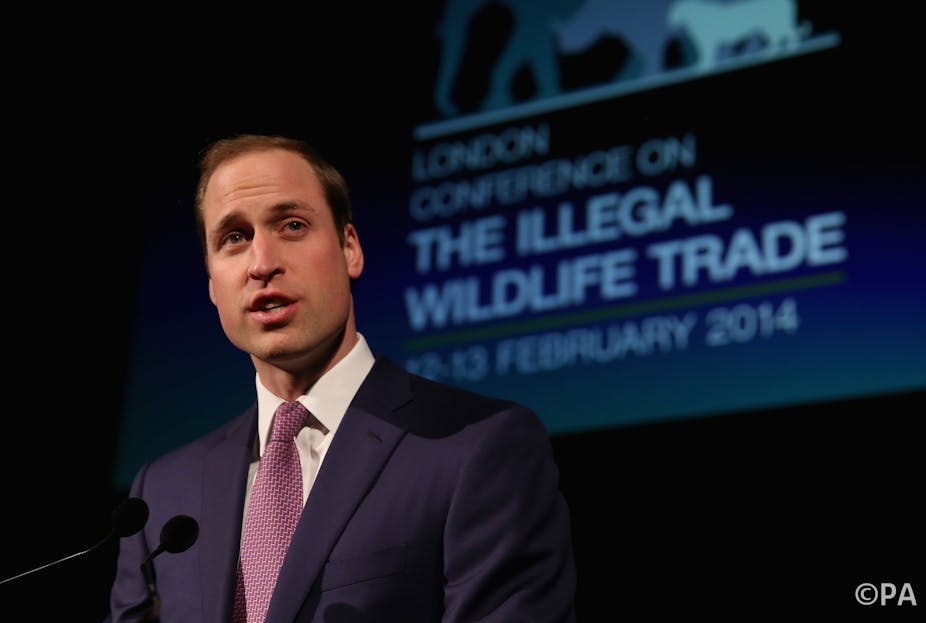Addressing the conference on illegal wildlife trafficking in London, Prince Charles said it “broke new ground”, while Prince William said it represented an “unprecedented gathering” that has “never before happened”.
This suggests a case of dynastic forgetfulness in the House of Windsor, as it was Edward, Prince of Wales in 1933 who enrolled prime minister Ramsey Macdonald into convening a London Conference on African Wildlife.
There are some striking similarities between these two conferences. Both respond to the fear that treasured species will become extinct. Both were small affairs bringing together governing elites (40 delegates in 1933 and 46 in 2014) and both were dominated by experts from the UK and US. Both meetings were premised on the belief that endangered wildlife can be saved if heads of state, royalty, and celebrities use their influence.
A tale of two meetings
But there are also intriguing differences between the two meetings. In 1931, Richard Hingston published in The Geographical Journal an independent analysis of wildlife threats and solutions which remains a model conservation assessment. It specifies values and assumptions, summarises issues at stake, discusses cultural perspectives, and sets out clear policy criteria, targets and management principles. Hingston doubted whether, without action, the elephant, rhinoceros and hippopotamus would survive 50 years. He identified the spread of agricultural cultivation, demand for animal products, hunting, and disease as the main threats.
In contrast, the evidence base for the 2014 conference consisted largely of news reports of organised crime and rebel militias butchering wildlife to feed a multi-billion dollar black market in Asia. The few scientific assessments focused on modelling illegal killing and population declines: an in-depth independent assessment of the how those markets functioned was missing.
A second notable difference was rhetoric. Last week’s conference sounded distinctly militaristic: Prince Charles said “Africa is at war to save its wildlife,” framing the illegal wildlife trade as a “battle” against a villainous enemy, the criminal networks supplying ignorant consumers in the Far East.
In contrast the tone of 1933 was less accusatory, emphasising instead the constellation of forces causing the problem. A few days after the conference, Prince Leopold of Belgium told the African Society, “The history of mankind has been marked by periods of indifference towards Nature,” arguing that society was returning to the idea that when we experience and contemplate nature it enriches lives. “The economic advantages due to the protection of nature are apparent to everyone,” he said. In short, responsibility for the decimation of wildlife lies with humankind. It is not something we can or should pin on one group.
Heated rhetoric, but what else?
The marked difference between these two conferences 80 years apart is the outcome. The first resulted in the International Convention for the Fauna and Flora of Africa which established a system of National Parks and nature reserves. The convention also included articles to protect species at high risk of extinction, to stop the trafficking and trading of articles manufactured from trophies, and to respect native rights. Adopted in British colonies outside Africa such as India and Indonesia, the convention established the foundations and institutional architecture for wildlife conservation over the next century. And it succeeded, in that none of the listed mammals in Africa have gone extinct.
In contrast the declaration arising from last week’s conference is more modest in status and scope. It calls upon the international community to eradicate demand and supply for illegal wildlife products, passing laws if necessary, improve enforcement, destroy seized contraband such as ivory caches, and address corruption and money laundering issues.
Given the growth and complexity of international environmental frameworks since 1933 it’s unrealistic to expect anything more than this. But we might have expected a more progressive, inventive approach: national parks introduced by the 1933 convention were still a novel idea outside the US. By accident or design, the fact they were introduced worldwide through the empire before its subsequent decline has been beneficial. In contrast the proposed measures from last week – of enforcement, corruption crack-downs and demand reduction – are all top-down techniques of “big government”. Leaders of the future will need a broader range of approaches, with which to approach the modern world’s messy, networked, multi-polar nature.
New approaches, new voices needed
Writing 80 years ago, Hingston insightfully wrote, “The one great hope [for African wildlife] lies in converting the living animal into a commercial asset.” Sustainable use and wildlife farming was marginalised at last week’s meeting, dismissed by John Robinson of the World Conservation Society as “often untested” and “while academically intriguing, unlikely to be feasible in the short term”.
This is a statement of ideology rather than evidence. Market-based approaches to governing supply-chains (for example FSC forest certification and crocodile farming) have been around for 20 years and subjected to detailed academic and policy scrutiny.
South Africa and other African countries promoting sustainable use have made a compelling case, based on experience, for a legal trade in rhino horn, and have cautioned against mass destruction of ivory stocks. It’s telling that the South African perspective was granted only 20 minutes, with no South African delegates at the highest level meeting.
Prince William’s pledge to continue the Royal family’s tradition of supporting the wildlife conservation movement provides a publicity boost. His initiative in forming conservation NGO collaboration United for Wildlife demonstrates a willingness to lead. And the alignment of global security concerns, through the involvement of armed groups with trafficking, with conservation efforts is potentially beneficial.
But the fact remains that prohibition of drugs, alcohol and other natural products have a poor record of success. In order to achieve his vision of a truly effective conservation collaboration, all concerned will need to bring together a broader range of insight, expertise, experience and ideas than that.

